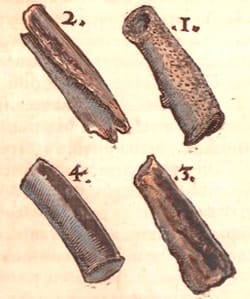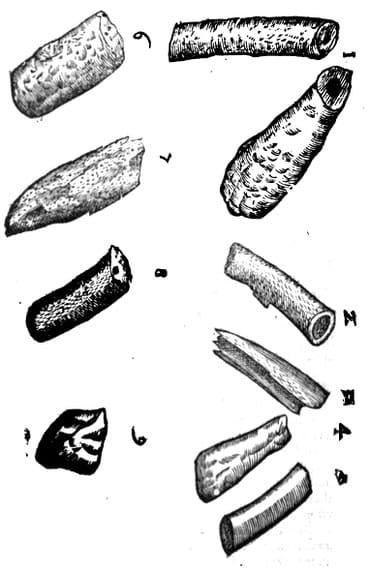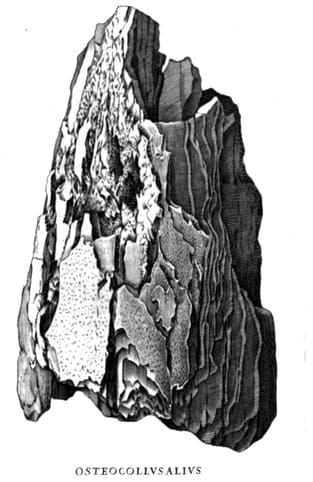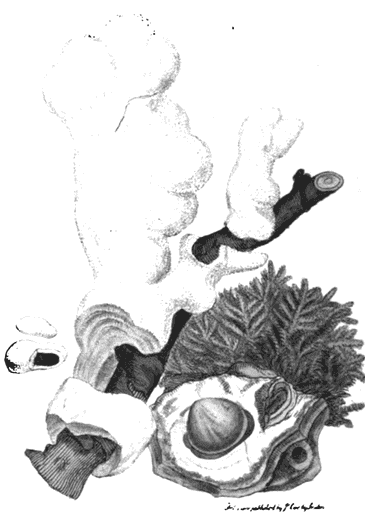Osteocolloa
Ostrites, Bone-builderOsteocolla is a medicine whose identification was long obscure. It is a calcium tufa formed around plant stems or tree roots in sandy areas, usually coastlines. It is heavy, hard, white or pale grayish and brittle, usually with a hollow core where the organic matter has rotten away, therefore appearing quite similar to bone. It is composed of calcium with silica and trace minerals. It was long regarded as an excellent medicine to promote healing of bones for which it was used topically and internally, often with Comfrey. For more information on Osteocolla, click here.
 Gesner, De Rerum fossilium, 1565
Gesner, De Rerum fossilium, 1565 Aldrovandi, Musaeum metallicum, 1648
Aldrovandi, Musaeum metallicum, 1648

|

|
Metallotheca Vaticana Opus Posthuman, 1719
 An illustration showing a root covered with Osteocolla
An illustration showing a root covered with OsteocollaBritish Mineralogy, Sowerby, 1811
Minerological name:
Tufa; a calcium encrustation formed around the roots of plants, usually in sand dunes.
Parts used:
Prepared Mineral
Temperature & Taste:
Cool, dry. Salty
Uses:
1. Strengthens Bones, Promotes Healing of Fractures:
-long regarded as specific to heal fractures, both internally and topically
-also for Dislocations
-it may be useful in Osteoporosis
2. Clears Heat and Poison:
-Fever, Epidemic diseases, Plague
-Poison
3. Stops Leakage:
-Leukorrhea
4. Topically:
-topically for Fractures and Dislocations
Dose:
Powder: 500mg–2 grams of the finely levigated powder
Preparation:
1. Prepared Osteocolla
It should be washed well, then foreign organic matter should be removed. It is levigated with water until extremely fine.
Schroder (Pharmacopoeia, 1656) said it should be levigated with Geranium water.
2. Quenched Osteocolla:
Heat the washed, cleansed, broken pieces, then quench in water, vinegar or a suitable distilled water to facilitate powdering.
Main Combinations:
1. Fractures:
i. Osteocolla with Comfrey (equal parts) for internal and topical use.
ii. Osteocolla (1 dram), Syrup of Comfrey (2 oz.), mix for a dose.
iii. Osteocolla prepared (1 oz.), Cinnamon (3 drams), Sugar (1 oz.). Powder, dose is 2 drams (Hildanus)
iv. Osteocolla taken with a decoction of Periwinkle in wine.
v. Osteocolla topically with Comfrey, Fenugreek meal as a plaster
vi. Osteocolla mixed into an ointment made of Cranesbill
vii. Diapalma plaster with Osteocolla, Comfrey, Marshmallow, Catechu, Camphor (Gazophylacium Medico-Physicum, Woyts, 1746)
2. Leukorrhea:
i. Osteocolla (half dram), Pomegranate bark (1 scruple), syrup of Quince, sufficient to form a Bolus
Cautions:
Only used for a short period, 10 days–2 weeks.
Main Preparations used:
Prepared Osteocolla
-
Extra Info
-
History
|
Salmon, Seplasium: It is called in Latin Ostiocolla, Osteocolla, Ostrites, Osteolithos, Holossues, Morochtus, and Sabulosis; in Greek Osteolithos; in English, Bone-Binder. It is found in the Palatinate, in Saxony, and Silesia, and grows on the sand like Coral. Schroder says it is glutinous, and speedily glues together broken bones, presently breeding matter for a Callus, thereby hastening the Conglutination. Dose in subtle powder 1–2 drams in any fit vehicle, and outwardly to be applied to the place in a Cataplasm or Plaster. Aldrovandus says, that broken bones being put into their places, and tied up, it heals them, using outwardly the Ointment made of Cranesbill, and taken inwardly with red Wine. It dries and binds without acrimony, and is good against Poison and the Plague. |
An Experimental History of the Materia Medica, Lewis, 1791: ‘… a fossil substance, found in some parts of Germany, particularly in the marche of Brandenburgh, and in other countries. It is met with in loose sandy grounds, spreading, from near the surface to a considerable depth, into a number of ramifications like the roots of a tree: it is of a whitish colour, soft while under the earth, friable when dry, rough on the surface, for the most part either hollow within, or filled with solid wood, or with a powdery woody matter’. ‘This earth has been celebrated for promoting the coalition of fractured bones and the formation of a callus; a virtue to which it does not seem to have any claim. It is found to be composed of two different earthy substances, which are nearly in equal proportions, and which may be separated from one another, by washing the powdered osteocolla with water: the finer matter, which washes over, appears from its burning into quicklime, and its properties in other experiments, to be mere calcareous earth, not different in quality from chalk: the grosser matter that remains is no other than sand’. |
